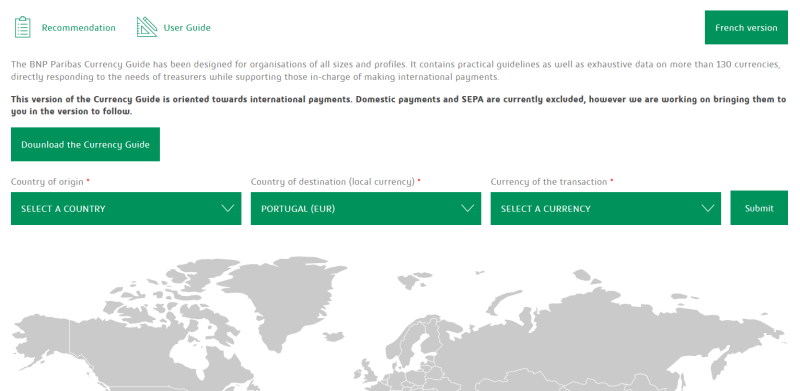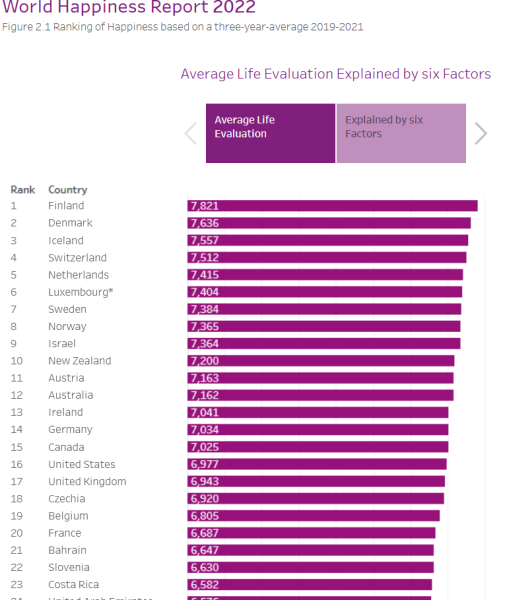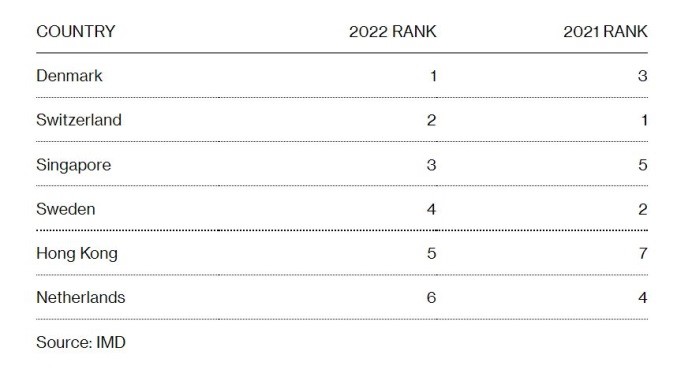TOMATO CATCH-UP - Newsletter Issue 248 – July/August 2022
Your monthly resource on working capital, process optimization, and issues related to the world of corporate treasurers, IT professionals, and bankers!
This newsletter is bilingual, English, German and sometimes also French, depending on the source.
Introduction
Remember how last year the holiday season caught us with more concerns than enthusiasm due to the fast-changing travel conditions and restrictions in certain destinations? This year looks similar, but our concern is different now. With a worrying global economic outlook, it seems we will likely have to rethink, revise and adjust our personal and business plans this summer.
In this context, we hope we come to you with fresh new insights that will inspire and bring more clarity in your perspectives and decisions.
This month’s Catch-Up includes topics such as Happiness and Competitiveness World Ranking, Income changes, Central banks, Monetary policies, Better Life Index, Interest Rates, ISO 20022.
Remember that for any challenge related to your financial issues, you can ask Martin Schneider for a discussion that will clarify it. Contact Martin via email or call +41 44 814 2001.
- Format ISO 20022 auch bald im Swift (ersetzt MT)
- BNP - Currency Guide for Treasurers
- Happiness, Trust and Competitiveness Worldwide
- Zentralbanken und deren Korrekturpotential
- Conclusion der Zinswende: Inflation Mai 2022
- Wie Google funktioniert? Antworten vom Schweizer Geschäftsführer
- Employment Rate and Earnings in OECD Countries
- Book Tip - Free Time: Lose the Busywork, Love Your Business
- Termine & Events
- From the Desk of Tomato
1. Format ISO 20022 auch bald im Swift (ersetzt MT)
Grundlage ist der Bericht von Gerhard Bystricky von der HypoVereinsbank. Das Format ISO 2022 in XML ist seit vielen Jahren im SEPA Raum im Einsatz. Einige Zahlformate, wie in Deutschland der AZV (Ausland-ZV), sind noch auf Text Format und harren der Umsetzung.
Ab dem 21. November beginnt die Migrationsphase im Swift-Netz auf das ISO 20022-Format für den Interbankenzahlungsverkehr. Die Übergangsfrist ist geplant bis November 2025, in der die Banken sowohl die bekannten MT (Message Types) als auch neu XML verwenden können.
Auch wenn die Umstellung die technischen Formate betrifft, hat sie erhebliche Auswirkungen auf die gesamten Prozesse der Unternehmen, die sich schon jetzt darauf einstellen können, wie Gerhard Bystricky von der HypoVereinsbank betont.
Das neue Format bringt mehr Transparenz und Verbesserungen im Auslandszahlungsverkehr. Künftig könnten die Kunden bei der Zahlungsauslösung eine eindeutige Zahlungsreferenz, eine strukturierte Adresse (Tomato NL Juni 2022) und zusätzliche Informationen über den Zweck der Zahlung angeben.
Während der Umstellungsphase wird Unternehmen empfohlen auf ihre Bank zugehen, um das Angebot einer parallelen Bereitstellung von Camt- und MT940 Kontoauszügen abzustimmen.
Martin Comment:
Die ISO und CAMT Formate, basierend auf XML sind ein beispielloser Erfolg seit 2014 (Start SEPA-Euro-Zahlungsverkehr). Wir von Tomato freuen uns sehr auf weitere weltweit bessere Strukturen und Standards in allen Financial Flows. Dank einem Format werden unsere Lösungen einfacher beim ausgehenden Zahlungsverkehr ISO 20022 und beim Ausziffern der Bankbestätigungen mit Gutschrift und Belastungsanzeigen in CAMT. Unsere Lösungen bei Ihnen wird mit der De-Zentralen Payment Factory vereinfacht auf wenige Formate.
Es gibt weiterhin viel zu tun, insbesondere an der Peripherie eines Konzerns: In den USA werden die Checks durch ISO 2022 ersetzt, zum Beispiel die Bankanbindungen an ein zentrales Cloud-Headquarter-E-banking ersetzt. So z.B. an Coupa Payment Modul, Fides aber auch SAP mit dem BCM (Bank-Communication-Manager) und der direkten SAP-Anbindung an wenige Hausbanken mit SAP-MBC (Multi-Bank-Connector).
Das Resultat ist ein viel, viel besseres IKS. Wenn Ihr ERP auf INFOR oder MS-D365 läuft sind weitere Lösungen gefragt. Fragen Sie Tomato !
Die Optimierungen aller Gruppenweiten Financial Flow (Seite 5-8 in PDF) sind weiterhin gültig. Tomato’s Kosten sind weiterhin auch mit ISO 20022 und CAMT ein Kleinstteil Ihrer Einsparungen.
Wann legen Sie los?
2. BNP - Currency Guide for Treasurers
We’ve just come across an interesting guide for treasurers from BNP Paribas, which has been designed for organizations of all sizes and profiles. The guide offers guidelines and data on over 130 currencies and is useful for those in charge of making international payments.
The guide is in English and French. Best before start is to read top left the recommendations and user guide.
Then browse by mouse over the landscape of choose by dropdown menus.
This version of the guide is oriented towards international payments.
For an example: I tried to pay CSK from Germany to Spain. The result is two formats Swift Message Type MT101 and ISO XML Pain.001. - Try it out. Bravo to BNP staff members.
Attention: EUR SEPA and local payments are planned for the next version.

Guidelines for all currencies:
- Provide sufficient information, unless there will be delayed/rejected payments
- In some countries, the IBAN format is mandatory; in all other cases, the usage of an IBAN is recommended
- Add a clear reason/purpose of payment
(providing only a number without guiding information can result in errors or delays) - Add information in English and in Latin characters
Currency Guide to the English Version BNP
Votre langue préférée c’est le français ?
Nous venons de découvrir un guide intéressant pour les trésoriers de BNP Paribas, qui a été conçu pour les organisations de toutes tailles et de tous profils. Le guide propose des directives et des données sur plus de 130 devises, utiles pour les personnes chargées d'effectuer des paiements internationaux.
Le guide est en anglais et en français. Le mieux avant de commencer est de lire en haut à gauche les recommandations et le guide d'utilisation.
Ensuite, naviguez avec la souris sur le paysage ou choisissez par des menus déroulants.
Cette version du guide est orientée vers les paiements internationaux, avec les paiements nationaux.
Pour un exemple : J'ai essayé de payer CSK de l'Allemagne vers l'Espagne. Le résultat est deux formats : Swift Message Type MT101 et ISO XML Pain.001. - Essayez-le. Bravo aux collaborateurs de la BNP.
Attention : Les paiements EUR SEPA et locaux sont prévus pour la prochaine version.
BNP currency Guide baser en Français BNP
3. Happiness, Trust and Competitiveness Worldwide
World Happiness Report 2022 uses individual-level data from 2017 through 2021 to examine what has changed for people.
Key findings:
- Finland continues to occupy the top spot, The Nordic countries are leading as usual, Switzerland is 4th; Germany 14th France reached its highest ranking to date with 20th, while Canada slipped to its lowest ranking ever;
- Life evaluations rose significantly in Serbia, Bulgaria, Romania, Hungary, Togo, Bahrain, Latvia, Benin, Guinea, and Armenia, while the largest drops were Lebanon, Venezuela, Afghanistan, Lesotho, Zimbabwe, Jordan, Zambia, India, Mexico, and Botswana;
- Worry and sadness have been rising over the past ten years;
- Anger remains much less frequent, with no significant trend changes;
- Stress is higher now than ten years ago in every global region; it rose faster in Eastern than Western Europe;
- Trust in public institutions has grown slightly since 2012;
- The current gap in life evaluations between Western and Eastern Europe is now less than half what it was ten years ago;
- Perceived levels of corruption fell since 2010 in all regions except for Latin American countries;
- The biggest increases in inequality have been in Sub-Saharan Africa and MENA.
 Read the entire list of findings from the World Happiness Report 2022.
Read the entire list of findings from the World Happiness Report 2022.
When it comes to competitiveness, Denmark has overtaken Switzerland as the world’s most competitive economy after the Nordic country outperformed others during the pandemic. Denmark took 2022’s top spot for the first time in the 34 years that the IMD Business School has published its World Competitiveness Ranking.

The entire story on Bloomberg.
4. Zentralbanken und deren Korrekturpotential
Olivier Kessler, Ökonom, Publizist und Direktor des Liberalen Instituts in Zürich, kommentiert die Entpolitisierung des Geldsystems in unserem eigenen Interesse.
Er stellt fest, dass sich die Wirtschaft in den letzten Jahrzehnten nie anpassen konnte und sich ein immer grösseres Korrekturpotenzial angehäuft hat. Die Leitzinsen erreichten kaum je wieder das Vorkrisenniveau. Der Trend zeigte nach unten, bis er vor einigen Jahren sogar ins Negative drehte - ein Phänomen, das in einer freien Marktwirtschaft logischerweise nicht möglich wäre.
Obwohl ein Kreditnehmer nominell den gleichen Betrag schuldet wie zum Zeitpunkt der Kreditaufnahme, werden die Schulden real durch die Inflation zunehmend aufgezehrt. Daher hat die Verschuldung in den letzten Jahren stetig zugenommen, was bedeutet, dass die Zentralbanken immer weniger Spielraum haben, um die Zinssätze zu erhöhen.
Lehren für die Zukunft:
- Markt und Wettbewerb halten sich länger;
- planwirtschaftlich regulierte Bereiche sind früher oder aber meist später zum Scheitern verurteilt;
- mehr Fokus auf Geldentstaatlichung (von Nobelpreisträger Friedrich August von Hayek): Ersetzen der gescheiterten monetären Planwirtschaft durch eine neue;
- die Trennung des Geldsystems vom Staat kann übertriebene Konjunkturzyklen und Fehlinvestitionen lösen, die zu wiederkehrenden Finanz- und Wirtschaftskrisen führen,
- ein marktwirtschaftlicher Zinssatz würde sich wieder durchsetzen.
Kessler kommt zu dem Schluss, dass die Entpolitisierung des Geldsystems zwar für viele noch illusorisch klingen mag, wir uns aber in unserem eigenen Interesse damit befassen sollten, da dies der einzige Weg ist, ein nachhaltiges Geldsystem zu schaffen.
Details zu Oliver Kessler’s Bericht in der Finanz und Wirtschaft (FUW)
5. Zinswende und Inflation
Ein Rückblick auf den UBS Webcast vom 22.06.2022 mit Dr. Daniel Kalt, Chief Investment Office, Wirtschafts- und Finanzmarktperspektiven.
Der Podcast dauert 31 Minuten:
- die ersten sieben Minuten gelten der weltweiten Wirtschaft und Zins,
- gefolgt von den Aktien und Anlagemärkten,
- ab Minute 13 widmet er sich dem Immobilien- und Hypothekarmarkt in der Schweiz,
- das letzte Drittel sind Q&A.
UBS Webcast 31 Minuten in Deutsch
Nachfolgend zwei anschauliche Inflations-Grafiken aus «Die Volkswirtschaft» 30.06.2022:
- Bild 1 die Inflation in Europa mit USA, (China, Japan eingefügt von Tomato)
- Bild 2 der Warenkorb von 6 ausgewählten Ländern
links nach rechts Schweiz, Deutschland, Tschechien, Frankreich, USA, Italien
Details Die Volkswirtschaft in Deutsch
Vous préférez le français? Ci-dessous deux graphiques clairs tirés de La Vie économique 30.06.2022:
- Image 1 l'inflation en Europe avec les USA, (Chine, Japon inséré par Tomato)
- Image 2 le panier de la ménagère de 6 pays sélectionnés
de gauche à droite Suisse, Allemagne, République tchèque, France, USA, Italie
Details La Vie économique en Français


6. Wie Google funktioniert? Antworten vom Schweizer Geschäftsführer
Möchten Sie Google Backstage sehen? Hier ein Interview aus «Die Volkswirtschaft» mit dem Google Geschäftsführer Patrick Warnking. Spannend zu erfahren wie Google funktioniert.
Martin’s Kommentar: Ein bisschen mehr an Zeit sollte ich für mich schon aufwenden, bei einem der wichtigsten Tools, das ich täglich nutze.
In Kürze:
- Alle Nutzer haben bei Google die volle Kontrolle über ihre Daten.
- Entscheidend ist, was Sie im Moment in die Suchzeile eintippen.
- Cookies von Drittseiten hinterlegt, altern schnell.
- Investieren Sie für IHRE eigenen Daten ein bisschen Zeit; man soll aber einmalig einlesen.
- Der Google Ansatz basiert auf vier Prinzipien:
1) Sicherheit der Daten.
2) Volle Kontrolle über die eigenen Daten.
3) Volle Transparenz, was mit den eigenen Daten passiert. - Jeder kann seine Daten einsehen und auch löschen.
Lesen Sie das Interview in Die Volkswirtschaft
7. Employment Rate and Earnings in OECD Countries
In OECD countries, 66% of the population aged 15-64 is in paid employment. Employment levels are highest in Switzerland (80%), Iceland and the Netherlands (78%) and lowest in South Africa (39%), Turkey (48%), Costa Rica (55%), Greece and Chile (56%). It is estimated that in OECD countries 84% of people with university degrees, polytechnic degrees or master craftsman's diplomas have a paid job, compared to only 44% of those without higher level education.
In 2020, 74% of men were in paid employment compared to only 59% of women. This gender gap is large in Turkey, Mexico, Costa Rica and Colombia, but relatively small in Canada, Iceland, Latvia, Lithuania and the Nordic countries.
Average earnings
In the OECD on average, people earn yearly USD 49,165, In the United States, Luxembourg and Switzerland, average earnings are more than twice as high as in the Eastern European countries, Chile, Greece, Hungary, Mexico and Portugal.
Read more on OECD Better Life Index
EU employment statistics from Eurostat:
- The EU employment rate (for people aged 20-64) went up from 71.7 % in 2020 to 73.1 % in 2021;
- In 2021, the employment rate of 16 out of 27 EU Member States reached or exceeded their pre-pandemic level;
- Poland and Romania recorded the largest increases in the employment rate between 2019 and 2021.
Read more on Eurostat Statistics Explained
Wie sieht es mit Zahlen zum Arbeitsmarkt 55+ aus?
In Deutsch die SwissLife Studie: Ein stetig wachsender Anteil der 55- bis 64-Jährigen ist erwerbstätig und diese Altersgruppe macht einen immer grösseren Prozentsatz aller Arbeitskräfte aus. Lesen Sie das PDF dies Swiss Life Studie Arbeitsmarkt 55+ (PDF 30 Seiten).
8. Book Tip - Free Time: Lose the Busywork, Love Your Business
Jenny Blake, the co-creator of Google’s acclaimed Career Guru coaching program, subtly points out the need to rethink our lifestyle and give our free time its due.
In her view, free time should not be about working as little as possible or creating a lifestyle business purely for one's own gain. It is about creating a life-giving business energizing every single person who is a part of it.
The author claims that a more joyful business is within reach:
- Traveling, going off the grid, or handling family emergencies without thinking of what happens while you are gone;
- Working 10- to 20-hour weeks, delegating the rest to a part-time remote team;
- Answering questions knowing you don't have to "own" the next steps;
- Concentrate your creative energy on the projects that excite you most.
Free Time is a playbook to free your mind, time, and team for your best work. This book will help you operate efficiently and intuitively while earning abundantly, so you can make your greatest contribution as a business owner.
Sneak Peek Book Excerpt PDF on Dropbox

9. Termine & Events
- Aug. 19, 2022: HSLU Weiterbildung CAS Corporate Finance: Unternehmerische Finanztransaktionen wie Mergers & Acquisitions (M&A), Private Equity als Finanzierungsquelle, Real Estate Management sowie Restructuring- und Turnaroundsituationen.
- Aug. 30, 2022: Swiss GAAP FER Event 2022 – Zurich, on site event by KPMG Switzerland on accounting standards.
- Sept. 13-14, 2022: Payments Leaders Summit by payexpo, Amsterdam, The Netherlands.
- Sept. 15, 2022: von 09.30-18.00 Uhr Der Swiss Treasury Summit ist das Schweizer Jahrestreffen der Treasurer in Rotkreuz bei Luzern.
- Oct. 4-5, 2022: Payments Leaders Summit by payexpo, London, United Kingdom.
- Oct. 11, 2022: Swiss GAAP RPC Event 2022 – Lausanne, on site event by KPMG Switzerland on accounting standards.
- Oct. 12 – 14, 2022: Alpbacher Finanzsymposium, Tirol
- Nov. 9, 2022: ACT Annual Dinner 2022 by The Association of Corporate Treasurers, London, United Kingdom.
- Nov. 23 – 24, 2022: Structured Finance in Stuttgart
10. From the Desk of Tomato
As I was watering my garden this morning, a friend came by on her bike and stopped for a chat. She told me about her vacation plans, which involve her and her horse going to Denmark in a horse trailer and then riding the horse all the way back through Germany.
She smiled with enthusiasm as she shared this plan which involves eight weeks of silent time.
As the authors of the article The Power of Silence in a World of Noise point out, taking time for silence restores the nervous system, helps sustain energy, and helps our minds be more adaptive. Silence is also associated with the development of new cells in the hippocampus, which impacts learning and memory.
Cultivating sustained silence facilitates clear and creative thinking, and quiets inner as well as outer chatter. People like JK Rowling, Walter Isaacson, or Carl Jung have all had disciplined practices for cultivating periods of deep silence. Ray Dalio, Bill George, California Governor Jerry Brown, and Ohio Congressman Tim Ryan have also described structured periods of silence as important factors in their success.
Four practical ideas you can try:
- Punctuate meetings with five minutes of quiet time;
- Take a silent afternoon in nature;
- Go on a media fast;
- Take the plunge and try a meditation retreat.
Source and details HBR (Havard Business Review)
With these thoughts we wish you happy summer days in harmony with your inner voice.
Enjoy Martin & Tomato Team
